Deck 1: People in Motion: The Atlantic World to 1590
Question
Question
Question
Question
Question
Question
Question
Question
Question
Question
Question
Question
Question
Question
Question
Question
Question
Question
Question
Question
Question
Question
Question
Question
Question
Question
Question
Question
Question
Question
Question
Question
Question
Question
Question
Question
Question
Question
Question
Question
Question
Question
Question
Question
Question
Question
Question
Question
Question
Question

Unlock Deck
Sign up to unlock the cards in this deck!
Unlock Deck
Unlock Deck
1/50
Play
Full screen (f)
Deck 1: People in Motion: The Atlantic World to 1590
1
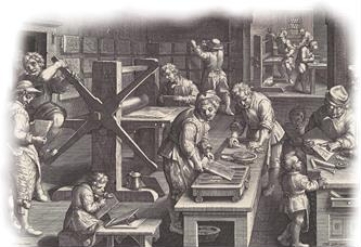
The engraving system that emerged as a result of the invention of the printing press and transformed visual culture .
A) relied on unskilled laborers
B) was a complicated multiple-stepped process
C) was a slow activity that led to the production of only one or two images per year
D) depended on simple and primitive tools
was a complicated multiple-stepped process
2
Aztec society was different from that of the mound builders and Anasazi in that only the Aztec
A) created urban areas
B) built remarkable structures
C) traded with other groups
D) practiced human sacrifice
A) created urban areas
B) built remarkable structures
C) traded with other groups
D) practiced human sacrifice
practiced human sacrifice
3
Olmecs, Maya, Toltecs, and Aztecs were advanced societies in .
A) the Mississippi Valley
B) Mesoamerica
C) South America
D) the American Southwest
A) the Mississippi Valley
B) Mesoamerica
C) South America
D) the American Southwest
Mesoamerica
4
How did the Archaic Era Indians differ from the Paleo-Indians?
A) Both men and women hunted large mammals together in small bands.
B) They developed a written language system.
C) They were the first to use the spearheads now known as Clovis points.
D) They learned how to collect and plant seeds.
A) Both men and women hunted large mammals together in small bands.
B) They developed a written language system.
C) They were the first to use the spearheads now known as Clovis points.
D) They learned how to collect and plant seeds.

Unlock Deck
Unlock for access to all 50 flashcards in this deck.
Unlock Deck
k this deck
5
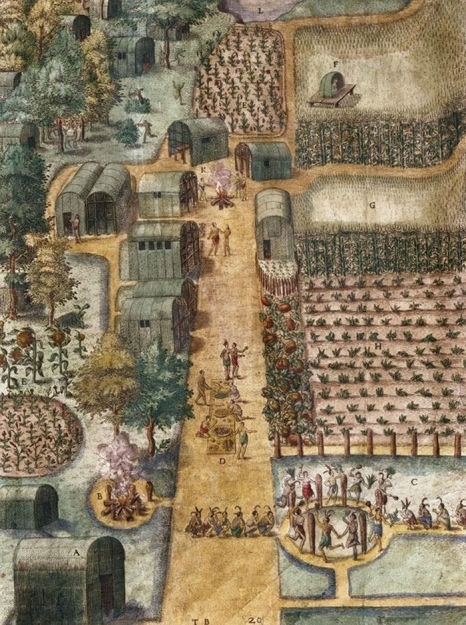
Based on this engraving of the village of Secoton, how did the Eastern Woodland Indians differ from Mesoamerican Indians?
A) Their social structure was rigidly hierarchical.
B) They constructed large homes of adobe and stone.
C) Their food source was limited to hunting large game and gathering wild plants.
D) Their outlook was more communal than individualistic.

Unlock Deck
Unlock for access to all 50 flashcards in this deck.
Unlock Deck
k this deck
6
How did Ferdinand and Isabella transform Spain into a world power in the late 1400s?
A) They strengthened the power of the Roman Catholic Church.
B) They appointed Jews and Muslims to a council of political advisors.
C) They increased the power of the nobility.
D) They lowered taxes and increased agricultural production.
A) They strengthened the power of the Roman Catholic Church.
B) They appointed Jews and Muslims to a council of political advisors.
C) They increased the power of the nobility.
D) They lowered taxes and increased agricultural production.

Unlock Deck
Unlock for access to all 50 flashcards in this deck.
Unlock Deck
k this deck
7
How did the Aztecs modify their natural environment to develop a successful civilization centered on an island on Lake Texcoco?
A) They implemented a system of slavery based on captured prisoners of war and criminals.
B) They created a central plaza with towering pyramids which served as temples.
C) They constructed a system of dams and aqueducts to control lake levels and bring in fresh water.
D) They built elaborate earthen mounds to bury their dead.
A) They implemented a system of slavery based on captured prisoners of war and criminals.
B) They created a central plaza with towering pyramids which served as temples.
C) They constructed a system of dams and aqueducts to control lake levels and bring in fresh water.
D) They built elaborate earthen mounds to bury their dead.

Unlock Deck
Unlock for access to all 50 flashcards in this deck.
Unlock Deck
k this deck
8
What quality did the Renaissance and Reformation share?
A) a desire to maximize profits through capitalism
B) a rejection of the Bible
C) acceptance of art and sculpture that emphasized the beauty of the human body
D) a questioning of the status quo
A) a desire to maximize profits through capitalism
B) a rejection of the Bible
C) acceptance of art and sculpture that emphasized the beauty of the human body
D) a questioning of the status quo

Unlock Deck
Unlock for access to all 50 flashcards in this deck.
Unlock Deck
k this deck
9
In capitalism, the prices of goods and services are set by .
A) the monarchy and the church
B) bankers and merchants
C) the market
D) landowners
A) the monarchy and the church
B) bankers and merchants
C) the market
D) landowners

Unlock Deck
Unlock for access to all 50 flashcards in this deck.
Unlock Deck
k this deck
10
What left indigenous Americans most vulnerable to Europeans upon first contact?
A) their isolation and lack of exposure to many diseases
B) their conviction in magic and superstition
C) their lack of such animals as horses and camels
D) their lack of highly developed iron weapons
A) their isolation and lack of exposure to many diseases
B) their conviction in magic and superstition
C) their lack of such animals as horses and camels
D) their lack of highly developed iron weapons

Unlock Deck
Unlock for access to all 50 flashcards in this deck.
Unlock Deck
k this deck
11
The system of housing developed by the Anasazi in the American Southwest differed from other housing systems constructed by early complex societies in the Americas because
A) they had a sophisticated system of interconnected multi-roomed structures used for both religious ceremonies and housing
B) their homes were built on top of large earthen mounds
C) their wooden and bark structures could easily be assembled and reassembled as they moved when the seasons of the year changed
D) they lived on a series of islands connected by causeways and bridges
A) they had a sophisticated system of interconnected multi-roomed structures used for both religious ceremonies and housing
B) their homes were built on top of large earthen mounds
C) their wooden and bark structures could easily be assembled and reassembled as they moved when the seasons of the year changed
D) they lived on a series of islands connected by causeways and bridges

Unlock Deck
Unlock for access to all 50 flashcards in this deck.
Unlock Deck
k this deck
12
The Paleo-Indians were .
A) farmers with complex systems of trade and agriculture
B) residents of permanent settlements
C) the first human settlers of the Americas
D) those who migrated from Asia by land rather than by sea
A) farmers with complex systems of trade and agriculture
B) residents of permanent settlements
C) the first human settlers of the Americas
D) those who migrated from Asia by land rather than by sea

Unlock Deck
Unlock for access to all 50 flashcards in this deck.
Unlock Deck
k this deck
13
What trade goods from Asia were most sought after by Europeans?
A) new food products like chocolate and tomatoes
B) gold and silver
C) spices, silk, and cotton
D) prized dyes such as indigo and cochineal
A) new food products like chocolate and tomatoes
B) gold and silver
C) spices, silk, and cotton
D) prized dyes such as indigo and cochineal

Unlock Deck
Unlock for access to all 50 flashcards in this deck.
Unlock Deck
k this deck
14
In the engraving Amerigo Vespucci Awakens a Sleeping America, the native inhabitants of this new continent are portrayed as being _.
A) good-natured but primitive
B) sexual and savage
C) charitable and religious
D) well-educated but unsophisticated
A) good-natured but primitive
B) sexual and savage
C) charitable and religious
D) well-educated but unsophisticated

Unlock Deck
Unlock for access to all 50 flashcards in this deck.
Unlock Deck
k this deck
15
By 1400, most of the trade and finance in Europe was controlled by .
A) Venice and other Italian city-states
B) the new nation-states of Spain and Portugal
C) Muslim merchants in Eastern Europe
D) Dutch and Belgian cities like Amsterdam and Antwerp
A) Venice and other Italian city-states
B) the new nation-states of Spain and Portugal
C) Muslim merchants in Eastern Europe
D) Dutch and Belgian cities like Amsterdam and Antwerp

Unlock Deck
Unlock for access to all 50 flashcards in this deck.
Unlock Deck
k this deck
16
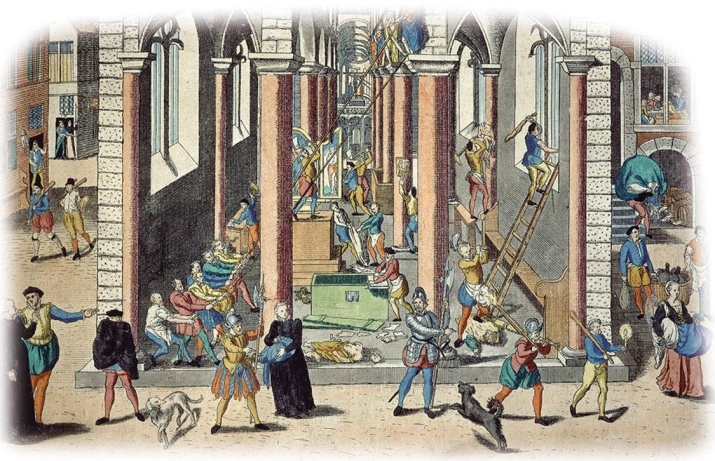
How does this illustration address one of the essential beliefs of Calvinism?
A) All images were forms of idolatry that had to be purged.
B) God had destined people for salvation before birth.
C) The true church was embodied by an "elect."
D) The damned could find salvation through good works.

Unlock Deck
Unlock for access to all 50 flashcards in this deck.
Unlock Deck
k this deck
17
The British monarch who separated from the Catholic Church to form the Church of England was .
A) Elizabeth I
B) Henry VIII
C) Edward VI
D) Ferdinand of Aragon
A) Elizabeth I
B) Henry VIII
C) Edward VI
D) Ferdinand of Aragon

Unlock Deck
Unlock for access to all 50 flashcards in this deck.
Unlock Deck
k this deck
18
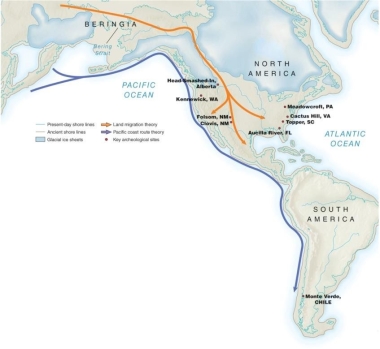
Based on this map, scholarly theories reveal that the first inhabitants of the Americas arrived by .
A) crossing a land bridge from Asia or traveling by boat
B) sailing westward from Europe and Africa across the Atlantic Ocean
C) migrating north from the southernmost points of South America
D) journeying by boat from Greenland to the eastern coast of North America

Unlock Deck
Unlock for access to all 50 flashcards in this deck.
Unlock Deck
k this deck
19
What defined the nation-states that emerged in Europe by the sixteenth century?
A) adherence to the Protestant religion
B) an unorganized military system
C) increased trade
D) centralized power
A) adherence to the Protestant religion
B) an unorganized military system
C) increased trade
D) centralized power

Unlock Deck
Unlock for access to all 50 flashcards in this deck.
Unlock Deck
k this deck
20
Eastern Woodlands Indians viewed nature as sacred, whereas Europeans primarily saw it as
A) a source of religious inspiration
B) something to control and exploit
C) an environment filled with animal spirits
D) a resource to conserve
A) a source of religious inspiration
B) something to control and exploit
C) an environment filled with animal spirits
D) a resource to conserve

Unlock Deck
Unlock for access to all 50 flashcards in this deck.
Unlock Deck
k this deck
21
The Spanish exported which of the following items from the lands they conquered in the Americas?
A) horses
B) gold and silver
C) luxury cloth such as silk
D) grains such as wheat and barley
A) horses
B) gold and silver
C) luxury cloth such as silk
D) grains such as wheat and barley

Unlock Deck
Unlock for access to all 50 flashcards in this deck.
Unlock Deck
k this deck
22
What argument was used to justify the enslavement of the Guanche of the Canary Islands by the Portuguese?
A) The Pope described them as "infidels and savages."
B) The Guanche were experienced sugar planters.
C) The Portuguese found them easy to capture.
D) The Guanche were immune to diseases such as smallpox and measles.
A) The Pope described them as "infidels and savages."
B) The Guanche were experienced sugar planters.
C) The Portuguese found them easy to capture.
D) The Guanche were immune to diseases such as smallpox and measles.

Unlock Deck
Unlock for access to all 50 flashcards in this deck.
Unlock Deck
k this deck
23
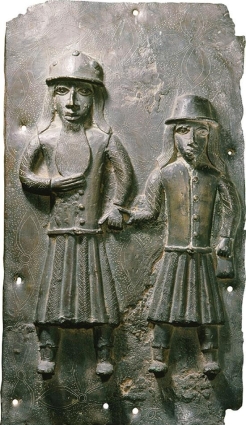
The kingdom of Benin in West Africa used bronze obtained from exchanges with
To create items such as this panel for its royal palace.
A) Muslim caravans
B) Portuguese traders
C) African kingdoms further to the south
D) Spanish conquistadores

Unlock Deck
Unlock for access to all 50 flashcards in this deck.
Unlock Deck
k this deck
24
The first Europeans to arrive in North America were the .
A) Portuguese
B) Vikings
C) Spanish
D) English
A) Portuguese
B) Vikings
C) Spanish
D) English

Unlock Deck
Unlock for access to all 50 flashcards in this deck.
Unlock Deck
k this deck
25

The objects in the drawing "Nova Reperta" represent .
A) religious artifacts used to convert Indians to Christianity
B) new products introduced to Europe from North and South America
C) technology borrowed from the Islamic world
D) new discoveries that made the exploration and settlement of the "New World" possible

Unlock Deck
Unlock for access to all 50 flashcards in this deck.
Unlock Deck
k this deck
26
Christopher Columbus planned to find a more direct route to Asia by .
A) traveling around the southern tip of Africa
B) taking an overland trade route across the Middle East
C) sailing west across the Atlantic Ocean
D) finding a Northwest Passage through the Arctic Ocean
A) traveling around the southern tip of Africa
B) taking an overland trade route across the Middle East
C) sailing west across the Atlantic Ocean
D) finding a Northwest Passage through the Arctic Ocean

Unlock Deck
Unlock for access to all 50 flashcards in this deck.
Unlock Deck
k this deck
27
What role did disease play in the Columbian Exchange?
A) The negative impact of disease was limited to the Indian population.
B) New food products discovered in the Americas infected Europeans with previously unknown diseases.
C) "New World" Indians were decimated by smallpox and other diseases brought by Europeans.
D) The diseases brought by Europeans to the "New World" wiped out large numbers of native animal populations.
A) The negative impact of disease was limited to the Indian population.
B) New food products discovered in the Americas infected Europeans with previously unknown diseases.
C) "New World" Indians were decimated by smallpox and other diseases brought by Europeans.
D) The diseases brought by Europeans to the "New World" wiped out large numbers of native animal populations.

Unlock Deck
Unlock for access to all 50 flashcards in this deck.
Unlock Deck
k this deck
28

Unlike other West African kingdoms and nations, Benin's decision to end its participation in the slave trade allowed it to .
A) trade exclusively with the Spanish
B) address humanitarian concerns for enslaved people
C) remain isolated from Europe
D) maintain its political autonomy longer than its neighbors did

Unlock Deck
Unlock for access to all 50 flashcards in this deck.
Unlock Deck
k this deck
29
The Igbos of West Africa were similar to the Eastern Woodland Indians of North America in that both societies .
A) practiced human sacrifice
B) were hierarchal in structure and organization
C) implemented a system of absolute rule by a monarch
D) traced their ancestry through the matrilineal side of their families
A) practiced human sacrifice
B) were hierarchal in structure and organization
C) implemented a system of absolute rule by a monarch
D) traced their ancestry through the matrilineal side of their families

Unlock Deck
Unlock for access to all 50 flashcards in this deck.
Unlock Deck
k this deck
30

How did the European concept of slavery differ from the African concept of slavery?
A) Slaves owned by Europeans were treated respectfully because they were valuable property.
B) European slavery was permanent and hereditary.
C) Africans worked their slaves harder than Europeans.
D) Slaves belonging to Europeans could attain positions of privilege.

Unlock Deck
Unlock for access to all 50 flashcards in this deck.
Unlock Deck
k this deck
31
Christopher Columbus's attitude toward the inhabitants of the Indies was primarily one of
A) resentment
B) reverence
C) cooperation
D) superiority
A) resentment
B) reverence
C) cooperation
D) superiority

Unlock Deck
Unlock for access to all 50 flashcards in this deck.
Unlock Deck
k this deck
32
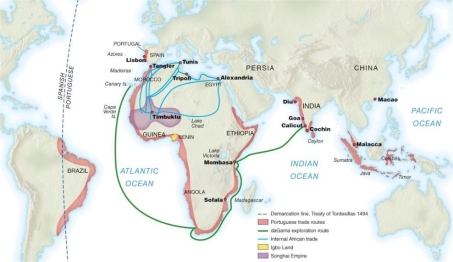
According to the map, how did Portugal establish more direct trading networks with Asia?
A) by sailing around Africa
B) through existing Mediterranean sea routes
C) along overland routes across the Middle East
D) by sailing west across the Atlantic Ocean

Unlock Deck
Unlock for access to all 50 flashcards in this deck.
Unlock Deck
k this deck
33
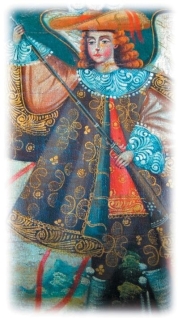
To the Indians of Central and South America, the painting "Heavenly Militia" demonstrates that the god-like power of the conquistadores mainly came from the Spanish practice of
A) wearing elaborate clothing
B) conducting religious ceremonies
C) using military weaponry
D) developing skilled horsemen

Unlock Deck
Unlock for access to all 50 flashcards in this deck.
Unlock Deck
k this deck
34
What was the Columbian Exchange?
A) the belief that Europeans should treat Indians as savages who were to be ordered about
B) the implementation of new technological skills to explore new lands and water routes
C) the biological encounter between the native peoples of the Americas and the first Europeans to cross the Atlantic
D) the introduction of Christian beliefs to the native peoples found in the Americas
A) the belief that Europeans should treat Indians as savages who were to be ordered about
B) the implementation of new technological skills to explore new lands and water routes
C) the biological encounter between the native peoples of the Americas and the first Europeans to cross the Atlantic
D) the introduction of Christian beliefs to the native peoples found in the Americas

Unlock Deck
Unlock for access to all 50 flashcards in this deck.
Unlock Deck
k this deck
35
Although Hernán Cortés was greatly outnumbered by the Aztecs, he was able to conquer this powerful empire because of alliances that he made with .
A) people who had been conquered by the Aztecs
B) slaves looking to win their freedom
C) the Inca Empire
D) other European settlers
A) people who had been conquered by the Aztecs
B) slaves looking to win their freedom
C) the Inca Empire
D) other European settlers

Unlock Deck
Unlock for access to all 50 flashcards in this deck.
Unlock Deck
k this deck
36

The demand for African slaves was fueled by the high profits being made from plantations on Portuguese colonies that grew and processed .
A) sugar
B) indigo
C) tobacco
D) cotton

Unlock Deck
Unlock for access to all 50 flashcards in this deck.
Unlock Deck
k this deck
37
The African slave trade was initially controlled by .
A) Spanish conquistadores
B) Portuguese merchants
C) Muslim traders
D) British sailors
A) Spanish conquistadores
B) Portuguese merchants
C) Muslim traders
D) British sailors

Unlock Deck
Unlock for access to all 50 flashcards in this deck.
Unlock Deck
k this deck
38

Though West African societies were as diverse as those in the Americas, they were different in that only West Africans .
A) had extensive trade networks
B) followed polytheistic religious traditions
C) practiced Islam
D) had both patrilineal and matrilineal societies

Unlock Deck
Unlock for access to all 50 flashcards in this deck.
Unlock Deck
k this deck
39
The most essential item involved in the trade routes between North and West Africa was
A) sugar
B) salt
C) fruits and vegetables
D) domesticated animals
A) sugar
B) salt
C) fruits and vegetables
D) domesticated animals

Unlock Deck
Unlock for access to all 50 flashcards in this deck.
Unlock Deck
k this deck
40
After indigenous workers on the Caribbean islands were nearly wiped out by deadly diseases, the Spanish turned to for a new supply of labor.
A) Aztec prisoners of war captured after the conquest of Mexico
B) the African slave trade
C) Spanish prisoners and debtors
D) Jews, Muslims, and others who were expelled from Spain
A) Aztec prisoners of war captured after the conquest of Mexico
B) the African slave trade
C) Spanish prisoners and debtors
D) Jews, Muslims, and others who were expelled from Spain

Unlock Deck
Unlock for access to all 50 flashcards in this deck.
Unlock Deck
k this deck
41
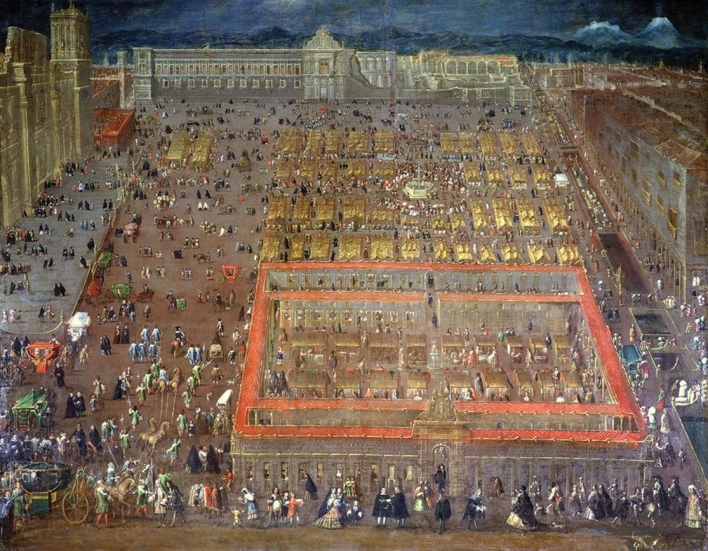
The French sent the Italian mariner Giovanni da Verrazano to North America in 1524 in order to .
A) establish fur trading stations along the St. Lawrence River
B) discover the Northwest Passage leading from the Americas to Asia
C) raid Spanish settlements and treasure ships
D) start plantations to grow cash crops

Unlock Deck
Unlock for access to all 50 flashcards in this deck.
Unlock Deck
k this deck
42
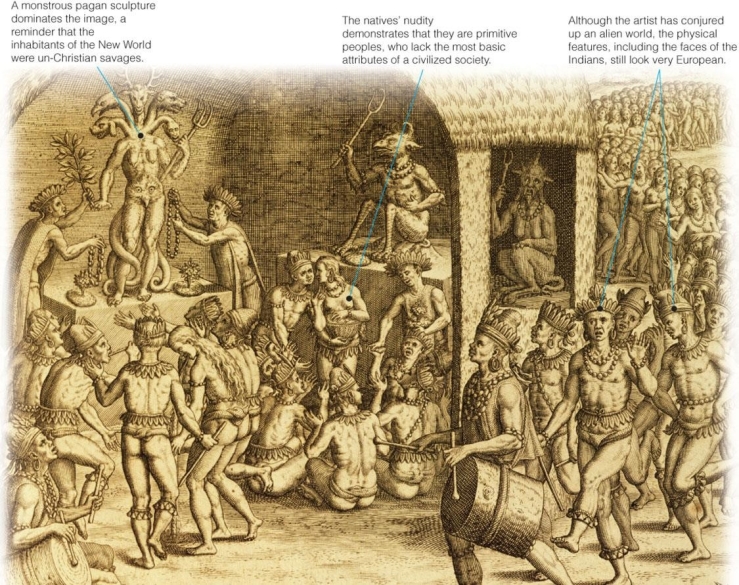
How did Theodore de Bry represent the religious beliefs of Native Americans?
A) His engravings showed that Indians participated in religious ceremonies similar to those of Catholic and Protestant Europeans.
B) He emphasized the "otherness" of the indigenous ceremonies that promoted the people of the New World as being un-Christian savages.
C) The European features shown on the Indians' faces made Europeans sympathize with them and accept their religious practices.
D) He showed how Catholic explorers from Europe exploited the indigenous people of the Americas.

Unlock Deck
Unlock for access to all 50 flashcards in this deck.
Unlock Deck
k this deck
43
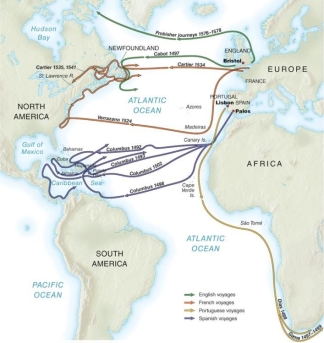
This map shows that in the exploration of the Atlantic world .
A) European nations each took different routes
B) the Caribbean Sea was in the control of the French
C) Europeans lost interest in exploration after the beginning of the sixteenth century
D) The English and French collaborated in exploring North America

Unlock Deck
Unlock for access to all 50 flashcards in this deck.
Unlock Deck
k this deck
44

What does the architecture shown in this painting of the central plaza of Mexico City reveal about Spain's approach to colonization?
A) Commerce was banned within the confines of the plaza.
B) The design of the plaza demonstrates the lack of urban planning used in Spanish colonial towns and cities.
C) The Spanish constructed buildings along the plaza to emphasize the strong power of the church and state.
D) Women were forbidden from attending events in public areas like the plaza.

Unlock Deck
Unlock for access to all 50 flashcards in this deck.
Unlock Deck
k this deck
45
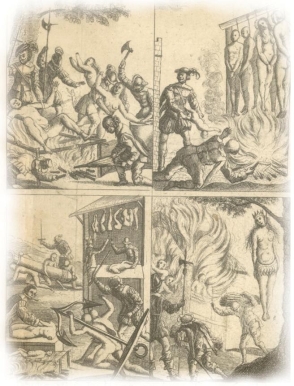
The writings of the Spanish bishop Bartolomé de Las Casas that appear in the English edition known as The Tears of the Indians portray the Spanish conquistadores as .
A) religious and humane
B) savagely brutal
C) kind and generous slave owners
D) victorious in celebration

Unlock Deck
Unlock for access to all 50 flashcards in this deck.
Unlock Deck
k this deck
46

The occupants of the first fleets initially sent by France to Newfoundland .
A) fished for cod
B) hunted for furs
C) mined gold
D) gathered lumber

Unlock Deck
Unlock for access to all 50 flashcards in this deck.
Unlock Deck
k this deck
47

What was the Black Legend?
A) Justifications for why Europeans in the Americas resorted to African slavery.
B) The tales of fabled cities of riches in the unexplored interior of the African continent.
C) The practice of French fur traders intermarrying with Indian women.
D) The legacy of the Spanish cruelty toward the native peoples of the Americas.

Unlock Deck
Unlock for access to all 50 flashcards in this deck.
Unlock Deck
k this deck
48
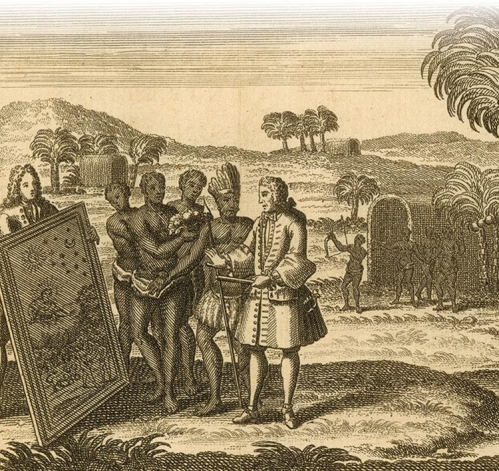
The French Jesuits' use of religious images to convert the Indians was most likely effective because these images .
A) intimidated the Indians until they converted in fear
B) were superior to the religious artwork of the Spanish and English
C) reminded the Indians of familiar religious figures in their culture
D) bypassed cultural and linguistic differences

Unlock Deck
Unlock for access to all 50 flashcards in this deck.
Unlock Deck
k this deck
49
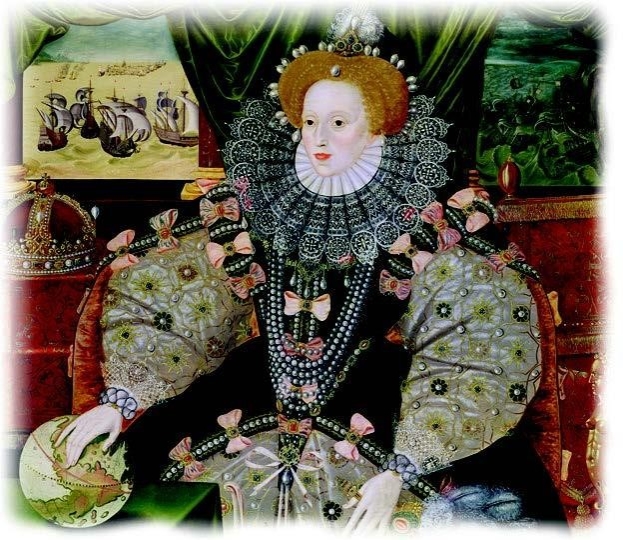
The portrait of Queen Elizabeth I shows that the balance of power in the Atlantic shifted near the end of the sixteenth century as a result of the English .
A) discovery of the Northwest Passage to Asia
B) establishment of tobacco plantations in Virginia
C) defeat of the Spanish Armada in 1588
D) development of a new colonial model in Ireland

Unlock Deck
Unlock for access to all 50 flashcards in this deck.
Unlock Deck
k this deck
50

What experiences learned during the colonization of Ireland were then applied by the English in their colonization of North America?
A) the forcible conversions of the Irish from Roman Catholicism to the Church of England under the threat of death
B) the lucrative routines learned about the wool trade in Ireland
C) the practices of expelling Irish farmers from their lands and establishing English-occupied plantations
D) the use of a tribute system where the English made the Irish perform hard labor in exchange for spiritual care

Unlock Deck
Unlock for access to all 50 flashcards in this deck.
Unlock Deck
k this deck



